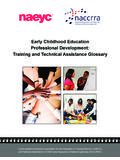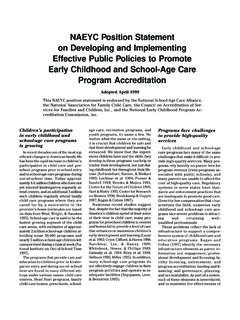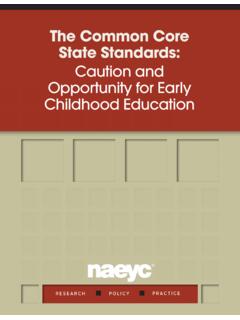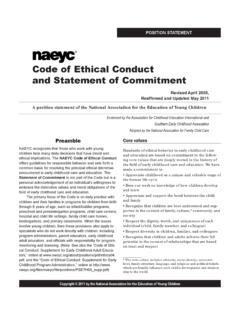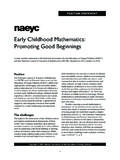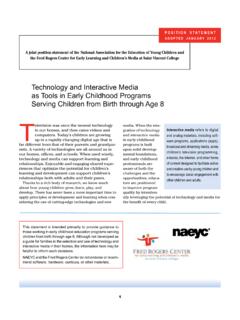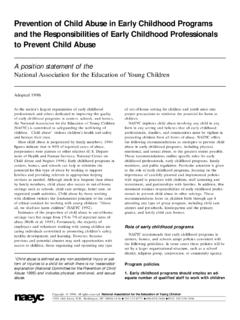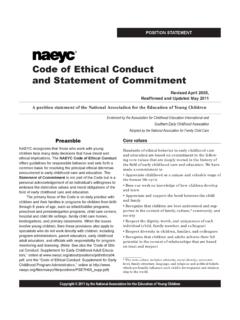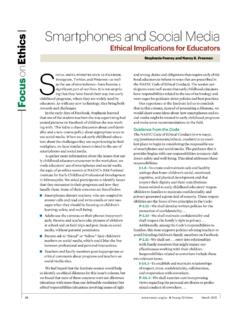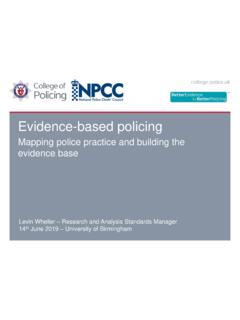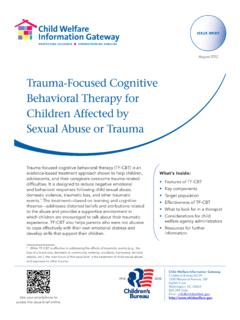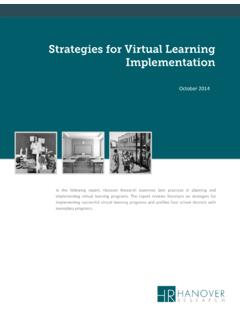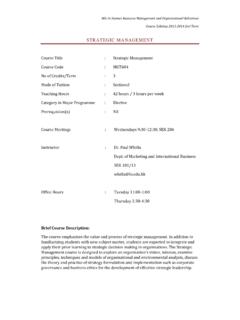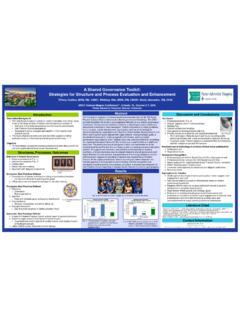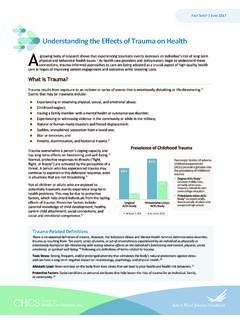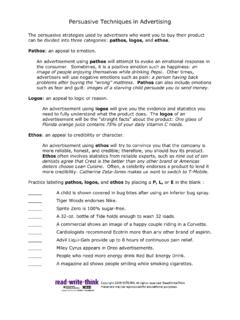Transcription of The Power of Documentation - NAEYC
1 88 Young Children March 20082, 3, 4 EARLY CHILDHOOD EDUCATORS might ask, What is Documentation ? or Is this Documentation ? They sometimes wonder, Can my bulletin board be Documentation ? What is Documentation ? Knowing what is Documentation is the first stage of understanding the process. Katz and Chard offer this explanation: Documentation typically includes samples of a child s work at several different stages of completion: photographs showing work in prog-ress; comments written by the teacher or other adults working with the children; transcriptions of children s discussions, comments, and explana-tions of intentions about the activity; and comments made by parents (1996, 2).Effective communication An effective piece of Documentation tells the story and the purpose of an event, experience, or development.
2 It is a product that draws others into the experience evidence or artifacts that describe a situation, tell a story, and help the viewer to understand the purpose of the Power of DocumentationHilary Seitz, PhD, is the early childhood coordinator in the Department of Teaching and Learning at the University of Alaska in Anchorage. Her wide range of early childhood experiences includes teaching in child care centers, a public preschool, and elementary schools. SeitzA parent eyes something on the wall in the hallway near her child s classroom. She stops and looks across the entire wall, as if trying to determine where to start. She moves to the left a bit and scans the bulletin board posted farther down.
3 At one point she nods as if in agreement and mouths a yes. Another parent approaches and turns to see what is on the wall. He too is mesmerized by the Documentation of what one child discovered about pussy willows by using an I-scope lens. When used effectively, consistently, and thoughtfully, Documentation can also drive curriculum and collabora-tion in the early childhood classroom that work A bulletin board can be a form of Documentation , but there are any number of other possible formats, including a presentation board con-taining Documentation artifacts and/or evidence ( Documentation panels), class books, portfolios, slide shows, movies, and other creative products. The format that Documentation takes can be as varied as the creator s mind permits.
4 Because Documentation should provide evidence of a process with a purpose, whatever the format, it should fully explain the process, highlighting various aspects of the experience or the Early Childhood ClassroomYoung Children March 200889 Audience and purposes Successful Documentation formats reflect the intended audience and purposes. In addition, the format selected will depend on the individual preparing the documenta-tion and how the children are involved in the experience. For example, if one teacher wants to highlight for families and administrators how the class is meeting a particular math or science standard, she would use examples of chil-dren participating in experi-ences that align with the stan-dard.
5 As evidence , she might include photographs of chil-dren measuring plant stems with a ruler, children s com-ments about measuring the stems, background informa-tion about how the children learned about measurement (or plants), and the specific learning standard the children are meeting by participating in this experi-ence. To best combine all of these elements, the teacher may choose a Documentation panel as the format to help the audience understand how children are learning. If children in the class are the intended audience, however, and the purpose of the Documentation is to help children reflect on their math and science learning and connect them to future lessons, then the teacher would select different artifacts and evidence .
6 A Documentation panel could again be appropriate, but different artifacts and evidence might include a web of children s ideas: for instance, why an Documentation Artifacts and evidence Teacher s description and overview of an event/ experience/skill development, such as photographs and descriptions of a field trip Photographs of children at work for example, con-ducting a science experiment Samples of children s work, like a writing sample from the beginning of the year Children s comments, such as All the rocks have spar-kles in them, in writing or as recorded by the teacher Teacher or parent comments about a classroom event for instance, It was really fun helping the chil-dren measure the ingredients for playdough Teacher transcriptions of conversations during small group time when children are exploring a new topic, such as why snow melts indoors Important items or observations relating to an event/experience/development, such as Johnny can now write his own name on his work Possible Topics to Document Individual child growth and development, such as language development progression Expected behaviors (at group time, in using a certain toy, while eating together) Curriculum ideas or events (field trips, presentations, special activities, celebrations)
7 Curriculum projects, such as learning about plant life cycles Families and relationships (different types of family structures and characteristics of the families in the classroom community) evidence of meeting learning standards (by posting work samples) Questions and answers of the children, teachers, and families about such topics as classroom routines (like how to wash your hands)elephant should not live at the Alaska Zoo, children s comments about the elephant, and questions for further exploration, such as, Where should an elephant live? Add related photo-graphs and work samples. Again, an explanation about where the learn-ing began and where it is intended to go will help any audience better understand the Documentation .
8 In both cases, the quality of the end product will depend on the teacher s understanding of children, the curriculum, and the standards, along with his or her effective use of tech-nology and should we document? A variety of experi-ences and topics are appropriate to document, but Documentation should always tell a complete story. To stay on track, carefully select one topic and explore it to the fullest rather than trying to do a little of everything. For example, if the class is learning about plants (and studying plant parts, how to grow particular plants, types of plants, and so on), it would be best to document fully just one aspect of chil-dren s a focus The teacher might choose to document only the children s study of plant parts, for exam-ple, and could start by provid-ing a learning spark, such as a new plant in To stay on track, care-fully select one topic and explore it to the full-est rather than trying to do a little of Children March 2008the classroom (Seitz 2006).
9 As chil-dren comment on the plant parts, the teacher can create a web to record what they know and to help them formulate questions. The children might also draw and label the various plant the topic and learning The teacher can combine all of these pieces to make a Documentation panel. This panel would illustrate the children s knowledge and understand-ing more thoroughly than a panel displaying every child s worksheet on plant parts, all of their water-color paintings of a plant, and every brainstormed list of vegetable plants. Offering specific examples of how children came to their understandings about just one aspect of a lesson in this case, plant parts achieves more than offering an overview of several developmental progress One important and common topic for Documentation is individual child growth and development.
10 As previous examples have shown, the documenter is a researcher first, collecting as much information as possible to paint a picture of progress and outcomes. Documenting individual growth requires a great deal of research, as the teacher must observe each child in a variety of areas of development (such as social-emotional, cognitive, language, and motor) over a substan-tial length of time. Only then can the teacher create a Documentation piece that tells an accurate story about each child. A teacher should be careful to avoid displaying private or confidential information in public forums. There are times when Documentation may be more appropriately shared in other, more private venues, such as a portfolio.
